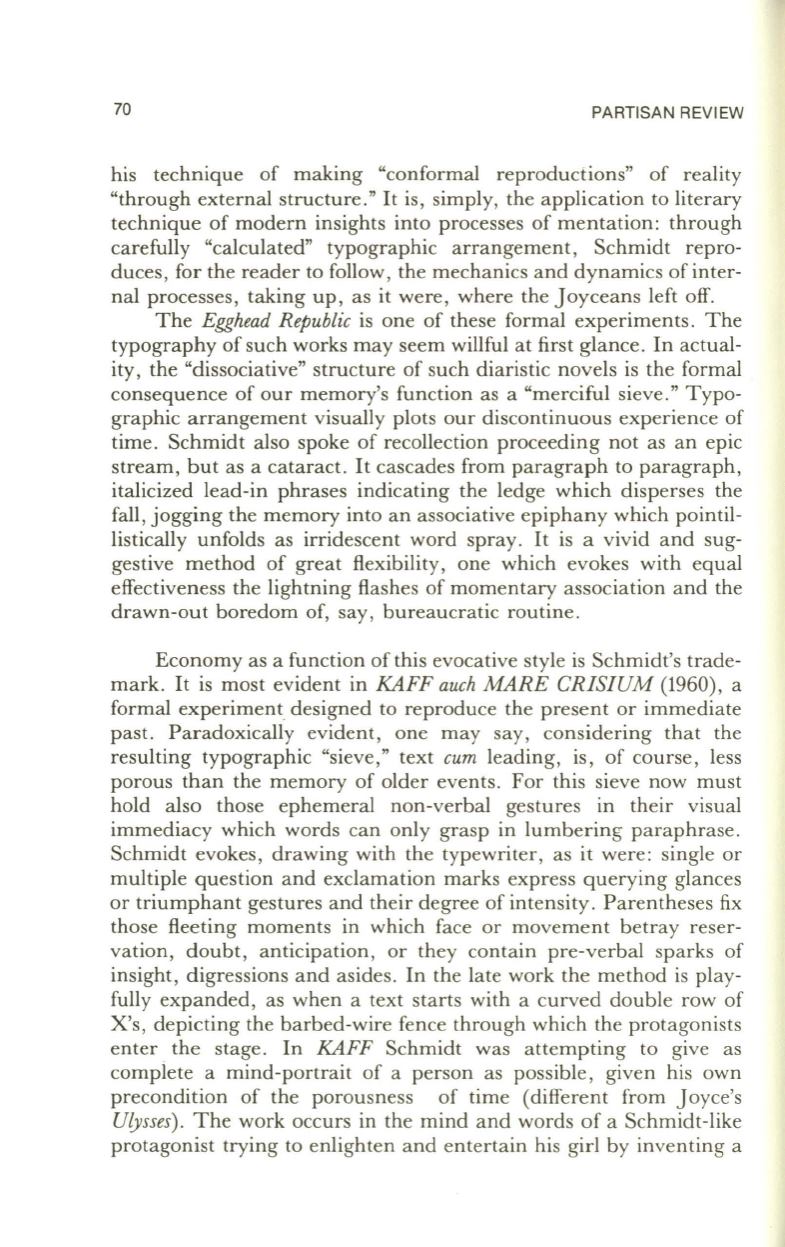
70
PARTISAN REVIEW
his technique of making "conformal reproductions" of reality
"through external structure."
It
is, simply, the application to literary
technique of modern insights into processes of mentation: through
carefully "calculated" typographic arrangement, Schmidt repro–
duces, for the reader to follow , the mechanics and dynamics of inter–
nal processes, taking up, as it were, where the Joyceans left off.
The
Egghead Republic
is one of these formal experiments. The
typography of such works may seem willful at first glance. In actual–
ity, the "dissociative" structure of such diaristic novels is the formal
consequence of our memory's function as a "merciful sieve ." Typo–
graphic arrangement visually plots our discontinuous experience of
time. Schmidt also spoke of recollection proceeding not as an epic
stream, but as a cataract. It cascades from paragraph to paragraph,
italicized lead-in phrases indicating the ledge which disperses the
fall, jogging the memory into an associative epiphany which pointil–
listically unfolds as irridescent word spray. It is a vivid and sug–
gestive method of great flexibility, one which evokes with equal
effectiveness the lightning flashes of momentary association and the
drawn-out boredom of, say, bureaucratic routine.
Economy as a function of this evocative style is Schmidt's trade–
mark. It is most evident in
KAFF auch MARE CRISIUM
(1960), a
formal experiment designed to reproduce the present or immediate
past. Paradoxically evident, one may say, considering that the
resulting typographic "sieve," text
cum
leading, is, of course, less
porous than the memory of older events. For this sieve now must
hold also those ephemeral non-verbal gestures in their visual
immediacy which words can only grasp in lumbering paraphrase.
Schmidt evokes, drawing with the typewriter, as it were: single or
multiple question and exclamation marks express querying glances
or triumphant gestures and their degree of intensity. Parentheses fix
those fleeting moments in which face or movement betray reser–
vation, doubt, anticipation, or they contain pre-verbal sparks of
insight, digressions and asides. In the late work the method is play–
fully expanded, as when a text starts with a curved double row of
X's, depicting the barbed-wire fence through which the protagonists
enter the stage. In
KAFF
Schmidt was attempting to give as
compiete a mind-portrait of a person as possible, given his own
precondition of the porousness of time (different from Joyce's
Ulysses).
The work occurs in the mind and words of a Schmidt-like
protagonist trying to enlighten and entertain his girl by inventing a


